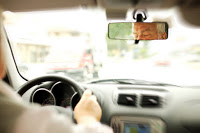Category Archive: Learners Permit Tips

Remember the Time Change Can Affect Your Driving
November 2, 2011
It’s that time of the year again; time to fall back and set the clocks to Standard Time. The time change can cause disruptions while our mind and body adapt to the new time and that disruption can extend to our driving.
Changing back from Daylight Savings Time to Standard Time occurs on the first Sunday in November and that falls on November 6th this year. The time change officially happens at 2:00 AM on Sunday November 6th. Falling back means setting the clock back one hour; at 2:00 AM set your clocks back to 1:00 AM. The great thing about falling back is that we all get an extra hour of sleep on Saturday night. Those who don’t get the word will probably arrive at church an hour early and wonder where everyone is or why that football game hasn’t started yet.
The time change is always somewhat confusing because it takes our minds a few days to adapt to the new change. Those of you who are used to waking up and beginning your morning commute in the dark will be waking up to the sunrise. Those who enjoy the extra sunlight after work will be getting home in the dark.
The time change in the fall isn’t as disruptive as the spring time change. In spring we lose an hour of sleep and sleep experts say that losing even one hour of sleep can have an impact on our driving and driving while drowsy is just as dangerous as driving under the influence. However, even though we aren’t going to lose any sleep, our driving can still be affected because of the time it takes our internal clock to adjust to the change.
Our internal biological clock or circadian rhythm regulates our wake sleep cycle. It was easy before clocks were invented; we woke up at dawn and we went to sleep when it got dark. Sleep experts also say it is natural for us to become sleepy in the late afternoon. In the modern world, our days are regulated by the clock and that mechanical clock can sometimes come into conflict with our biological clock. Some sleep experts suggest that we follow the example of Mediterranean cultures and allow employees to nap in the afternoon in order to gain maximum performance. When we force ourselves to remain awake through that natural afternoon drowsy time, it can lead to drowsiness behind the wheel on the long commute home. One survey of drivers found that more than one-third (35%) of drivers who nodded off while driving within the previous six months say their last experience occurred between 6:00 a.m. and 5:00 p.m. An additional 17% report they nodded off between 5:00 p.m. and 9:00 p.m.
A study using mice (that also has implications for humans) found that when circadian rhythm cycles were disrupted, the mice didn’t perform as well in maze tests as the control group whose circadian patterns weren’t disrupted. They also exhibited impulsive behavior which, for human drivers, can mean trying to beat that light or pulling out in front of another car. When darkness suddenly falls an hour earlier, drivers may find themselves driving a little faster; trying to get home before daylight fades.
Another problem occurs because light conditions at dusk – before total darkness – can be confusing. Shapes that show up clearly in daylight or in a car’s headlights may not show up as clearly at dusk. A study conducted in 1995 found that the number of auto/pedestrian crashes increased substantially in the period following the time change back to standard time. Kids are still walking home from practice or trying to get in a little extra playing time with their neighborhood pals before total darkness. A University of California trauma center found a “62 percent increase in the number of children in auto-vs-pedestrian crashes and auto-vs.-bicycle crashes in the two weeks following the October time change. Of these victims, 90 percent had severe injuries and required surgery.”
Until their body clock adjusts to the new time, drivers should be especially cautious during the first few weeks after the time change. Get plenty of sleep, don’t give in to the impulse to rush home to beat the sunset, and be especially watchful for pedestrians.
Drowsy driving prevention week is Nov.6 – 12. For more information on sleep and sleep disorders, visit the National Sleep Foundation’s web site at: http://www.sleepfoundation.org/
Prepping for a Homecoming: Communication
September 26, 2011
Here are some tips on exactly what to discuss when prepping for homecoming:
Communicate with other parents; then, talk to your teen about their friends’ parents. Being part of a social group does not guarantee that other parents share the idea of a zero-tolerance policy for alcohol. Some parents even choose to “look the other way” when hosting teen get-togethers, reasoning that at least, the teens are in a “safe” environment. This is illegal in any state. Communicate with these other parents to find out if they know where their teens will be after homecoming night. Even better, if the teens plan to spend time in another teen’s home, find out if the parents are willing to chaperone. Communicate the importance of accounting and locking up alcohol in their homes. When communicating with your teen, make sure that they know that it’s always alright to say “no.” Ask if they will be riding with teens whose parents also have a zero-tolerance policy for alcohol.
Come up with a safety code. This could be something a teen may text their parent if they are in an uncomfortable situation, and they need an exit. Something like a code to signal, “Get me out of here!” On your end, make sure that your teen knows that you will be discrete upon receiving this code. This could also be something that a teen can do to “check in” with their parents. Maybe texting something like, “dinner was awesome!” could mean that the teen has arrived at an after-homecoming destination safely.
Discuss the teen’s planned itinerary for the evening, and require the teen to inform you of any changes. Make teens feel they could trust you not to bug them on homecoming night, if they promise to keep their end of the bargain by checking in and informing you of any changes in the plan.
Doing so will hopefully make homecoming night a “night to remember,” instead of being “the night when my mom bugged me all night, until I got home.” Pre-plan, communicate and have fun!

The Two-Step Process of Getting a Driver’s License
July 12, 2011
Though the process of getting a driver’s license may be simplified to a few steps, it does not necessarily mean that it is an easy in-and-out operation. One has to prepare well enough to pass both processes. The process that most states have is the knowledge test and the road skills test.
The first step is the knowledge test – this is for getting a permit.
Knowing the proper rules of the road is important when getting a license, so the first test consists of a written road rules and road signs test. Once the new driver has proved they understand the rules of the road, they can receive their learner’s permit to allow them to actually learn the skills needed behind the wheel of a car. The learner’s permit is designed to give new drivers a period (six months to a year), in which they can learn to drive under the close supervision of an experienced licensed driver (21 years of age or older). Once the new driver has developed their driving skills and gained enough experience, they should be ready to pass their driving skills or road test.
The second step, of course, is the driving skills test.
The behind the wheel road test is designed to test the basic driving skills that everyone needs to safely handle a motor vehicle. The road test is really quite simple. Although the road test is quite simple, approximately twenty five percent of new drivers fail in their first try. The examiner will give the new driver instructions to perform simple driving tasks such as parking, making an emergency stop, and a three-point-turn. The test isn’t designed to try to trick the driver and the test examiner will not ask the new driver to do anything that is illegal. If a minor mistake is made, the examiner will note it on the test form. If enough minor mistakes are made, usually adding up to 30 points, the driver will not pass. However, most of the failures are due to simple but costly mistakes. Mistakes such as failing to stop completely at a stop sign or hitting the cones while trying to park are grounds for an automatic failure. New drivers should practice these maneuvers over and over until they are second nature before attempting to pass the road test.
If you hold a valid license from one state and are trying to get a license in a new state, most states will allow a transfer of licenses without any additional tests but some states may require that a driver take either the written road test or both the written test and the road exam. Check the your state’s DMV driving manual and be prepared.
The key to getting a driver’s license is: study well, practice well and be patient.

Top 5 Hints for Passing the DMV Road Test
July 8, 2011
Picture the DMV road test: new driver in the driver’s seat, driving examiner-with-clipboard-in-hand sitting beside him in the passenger’s seat, giving instructions and with an ever-so-tight grip on a pen, taking notes. The driving exam can be grueling for new drivers who are worried about passing/failing — in other words, anxiety may become a factor in passing the driving road test.
Here are the top 5 hints for passing the driving road test:
1. Get lots of practice during your learner’s permit period. In most states, there is a required waiting period from getting a permit or intermediate license before a new driver is allowed to take the road test. This is essentially the state giving the new driver a chance to practice all the skills needed to pass the road test.
2. Obey signs/signals and avoid hitting the cones/curbs. Just because the driving examiner is writing notes on the examination form, that doesn’t mean that new driver has made a mistake. The examiner has to write down the good things as well as the bad. Minor mistakes are allowed but, if those minor mistakes add up to 30 points, you will fail the exam. There are several things that will cause you to automatically fail the exam. Failure to obey traffic signals/signs or hitting the cones/curbs while parking or conducting the three-point-turn are the most common reasons for an automatic failure. For the stopping part, there’s this 4-second-stop rule: to be sure that the car is in a complete halt, step down on the brakes and count to 4 to make sure that the car is totally stopped. For the parking segments, ask a family member (who is a valid license holder) to show you exactly how to park the right way and then practice it – – a lot! Practice the three-point-turn on a narrow street. Practice makes perfect.
3. Follow the examiner’s directions, while demonstrating the ability to make the right decisions. The driving examiner will not ask you any trick questions nor will he or she ask you to do anything that is illegal. Driving is tricky enough all by itself so they don’t have to try to trick you. The examiner will give you straight, simple instructions. Don’t look for the hidden meaning in the instructions; just do as he/she says. If you truly don’t understand the instruction, ask for clarification. It is better to ask than to try to guess and make a mistake. The stupid questions are the ones that don’t get asked.
4. Obey the state’s driving law. This one’s pretty simple, even with varying laws between states, there are still driving laws that are common to most. An example would be:
- Properly wearing a seatbelt before starting the vehicle.
- Properly yielding to other traffic when changing lanes.
- Properly giving a turn signal when turning, changing lanes, or turning into or backing out of a parking space
- Safe driving around school buses and school zones. (There will usually be signs to follow.)
- Knowing the meaning of a Yield sign. Slow and look for other traffic or pedestrians crossing your path and be prepared to stop if necessary. If the way is clear, keep going.
- Stop for pedestrians in a crosswalk.
- Don’t follow too close, maintain a two to three-second following distance.
5. Make sure you have all of the documents that will be needed. In order to take the road test, you will need a current vehicle registration slip that matches the dates on your tags. You will also need a current proof of insurance form. Both of these documents should be in the vehicle at all times. For proof of your ID to get a license, you will need a minimum of the following (check with your local DMV for a complete list):
- Birth Certificate with raised seal (or current passport)
- Social Security Card
- More than one proof of address, such as your parent’s electric or home insurance bills.
You will also need:
- A form signed by your parent of guardian showing you have received the necessary number of driving instruction hours for both day and night driving.
- Your parent’s written permission to receive a license (if under the age of 18).
- A certificate showing you have completed any state required driver education.
Master the Driving Maneuvers for the Road Test with a “Behind-the-Wheel” Online Simulator Course

Learn How to Drive on your Spring Break
February 25, 2011
Mention the word “Spring Break” and images of vacations and getaways come to mind. The reality is: not everyone gets to go on spring break. While this may dishearten some teens, the good news is: it’s a great time to learn how to drive!
Don’t exactly know where to start? Here are some suggestions on getting started on some spring break learning:
- Consider a visit to the DMV office. Different states have different requirements, so knowing these is a good start. Also, dropping by the DMV will allow you to get materials such as driver’s manuals to help aide your study. This can also be done online, with most states having their own official DMV site.
- Practice for your DMV written test online with a drivers license practice test. When completing the online course you’re guaranteed to pass your written test.
- If you’re already have your learners permit, get practice. Most states require a minimum of 50 hours, so running errands at home can sometimes be a way for new drivers to get experience driving, or completing required hours for driving. It’s the perfect time to familiarize one’s self with the vehicle, and properly operating it.
- Learn basic vehicle troubleshooting. Learn how to check the oil. Learn how to change a tire. Basically, learn the basics of being prepared for anything.
- Have fun. Imagine the surprise your friends will get when they find out you got started on learning how to drive. Driving is a lifelong skill that is both a convenience and a privilege, and there’s no better time to begin learning than when you have a break from your other responsibilities.
